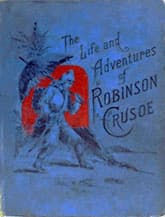Robinson Crusoe
Critique • Quotes • Text • At the movies
 1890 edition
1890 editionAlso called
The Life and Strange Surprising Adventures of Robinson Crusoe of York, Mariner
First publication
1719, England
Literature form
Novel
Genres
Literary, adventure
Writing language
English
Author's country
England
Length
Approx. 140,000 words

Future TV star Amanda Blake stars in the largely female production of Miss Robin Crusoe.
A female adventure
Miss Robin Crusoe (1954): Director Eugene Frenke; writers Harold Nebenzal, Richard Yriondo, Al Zimbalist; featuring Amanda Blake, George Nader, Rosalind Hayes
If Robinson Crusoe had been a woman, her name would have been Robin Crusoe, right? Not necessarily. Miss Robin Crusoe, a mainly female version of the castaway was produced under the title Miss Robinson Crusoe until a dispute arose over the possibility of its title infringing upon another movie being shot in Mexico at nearly the same time.
Although released in 1954 with a couple of up and coming Hollywood B actors in the leads, this low-budget film has remained obscure—to the point that I'm not sure if it has ever been released in any consumer format. When Miss Robin Crusoe was resurrected and shown on Turner Classic Movies a few years ago, viewers were surprised. Surprised either at finding a Crusoe movie they'd never heard of, or at finding it wasn't quite as awful as they'd expected.
The colour is gorgeous—especially in the lush jungle scenes filmed in the studio. The shoreline action scenes are obviously shot on the California coast with studio close-ups awkwardly inserted. A lovemaking scene in the surf rivals the more famous one in From Here to Eternity, which was produced just before this.
The lovers in this case are Miss Crusoe, played by Amanda Blake (best known for a later long-running role as Kitty on TV's Gunsmoke), and another castaway, Jonathan, played by George Nader, who had a run of hunky stardom in the 1950s. But until Jonathan shows up, most of the film centres on the adventures of two women: Crusoe and her native girl Friday (Rosalind Hayes, about whom little seems to be known). They take turns saving each other from marauding savages and look after each other with sapphic tenderness.
When the man arrives, he's first seen as something of an interloper, the subtext being that male presence threatens to break up female solidarity, if not deeper bonds. Crusoe fights off his charms. Friday is viciously jealous. They both suspect him of trying to double-cross them to effect his own escape from the island without them.
But, of course, he eventually wins them over. Crusoe confesses her love for him and all three are rescued.
Online video of 1954's little-seen film Miss Robin Crusoe.
As you can see, the story doesn't really follow the Defoe tale. The dialogue is hackneyed, the staging is amateurish and the action not believable. All in all, a movie that largely deserves to have been forgotten.
But the actors do their best with the weak material. And it's still mildly interesting to watch the only feminine version of Crusoe I can think of, if only to imagine how a better attempt might work.
Robinson Crusoe, the novel, is such a patriarchal and imperialist treatise that the thought of changes that would be wrought by women replacing the protagonists is rather intriguing. However, this film doesn't greatly help.
— Eric


